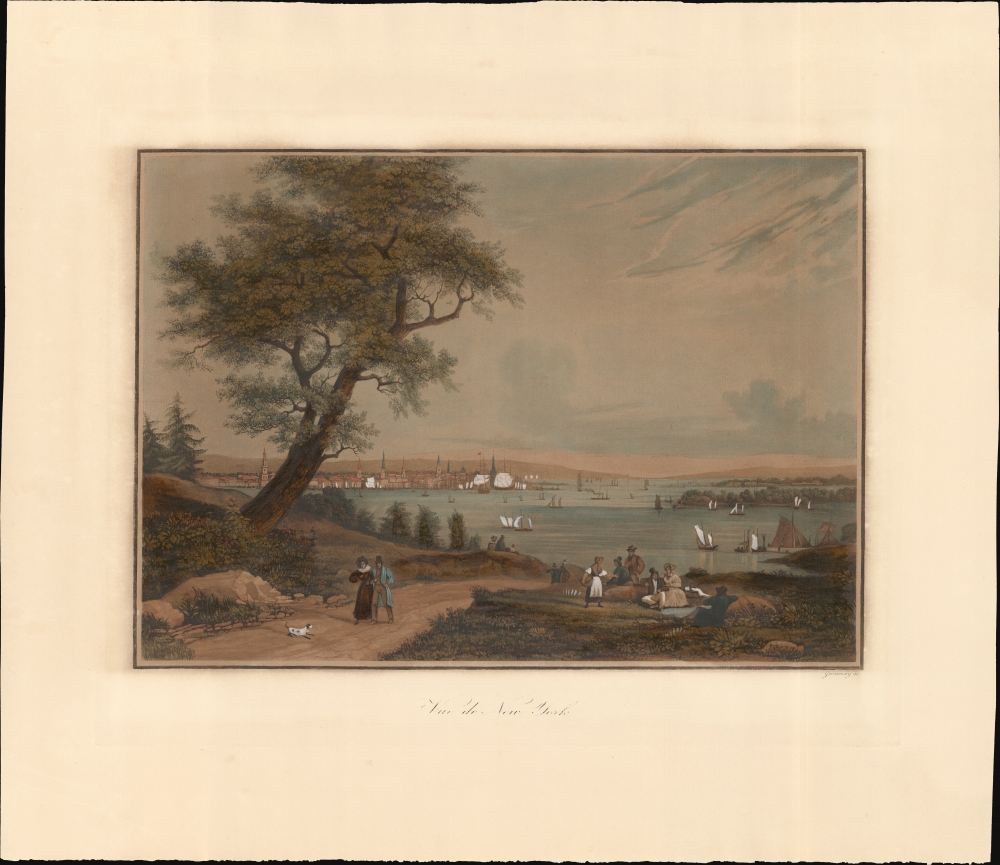1840 Garneray Aquatint View of New York Harbor
VueNewYork-garneray-1840
Title
1840 (undated) 12 x 16 in (30.48 x 40.64 cm)
Description
A Closer Look
The view looks east on lower Manhattan. Most suggest the view was drawn from Weehawken, from variant editions with subtext suggesting such. Nonetheless, based on the actual image, it was almost certainly drawn from a point further south, likely Jersey City. A pastoral scene occupies the foreground, with picnickers enjoying a summer day under the shade of a meticulously illustrated tree. To the right, we can recognize Ellis Island and beyond, Governor's Island. Lower Manhattan and New York Harbor occupy the foreground. Multiple buildings are recognizable, including the Merchant's Exchange (dome) and the steeples of Trinity Church and St. Paul's Chapel, among others. The harbor is filled with sailing ships, both smaller local vessels and larger oceangoing traders. In the skies above, dramatic clouds underscore the rich shading and tonal complexity a master of aquatints like Garneray could achieve.Publication History and Census
The view is undated. The original drawing, according to Stokes, likely dates to 1834. Stokes notes the distinctive dome of the Merchant's Exchange, built in 1821, but burned to the ground in 1835. The date can be further narrowed by the absence of the steeple of the Wall Street Presbyterian Church, destroyed by fire in 1834, but rebuilt in 1835. Thus, the view illustrated here can date no later than 1835. The exact printing date of this aquatint view is something of a mystery, but likely between 1835 and 1840. There are other better-known versions of the view, published in New York by Bailly Ward and in France by Basset, featuring additional text below the image. This view is attributed exclusively to Garneray and based on the paper and printing issued in Paris. It may be earlier, later, or contemporaneous with the more well-known Ward / Basset views.Cartographer
Ambroise Louis Garneray (February 19, 1783 - September 11, 1857) was a French navy man, privateer, painter, and writer. Garneray was born in the Paris Latin Quarter, the elder son of Jean-François Garneray (1755 - 1837), a royal painter and a pupil of Jacques-Louis David. Although initially trained as a painter, by his father, he joined the French Navy at 13. He sailed to the Indian Ocean, where he was involved in numerous battles and skirmishes, mainly with the British. For a time, he served on the privateer Tigre du Bengale. He was subsequently captured by the British and spent eight years as a prisoner of war in England before being released on May 18, 1914. He never returned to the sea as a sailor, settling as a painter in Paris. Through official connections, he became the first Peintre de la Marine, likely a position created specifically for him. From 1931 to 1930, he made sketches of harbors throughout France. In 1833, Garneray became the director of the Museum of Rouen. Around the same time, he developed a fascination with aquatints and became a master of this printing genre, producing numerous works. The 1840s were difficult for him. During this decade, he lost many of his official supporters and fell into penury. Nonetheless, in 1852, under Napoleon III, he was awarded the Legion of Honor by the Emperor himself. He died a few years later in 1857, curiously only a few months after his wife was mysteriously assassinated. More by this mapmaker...

